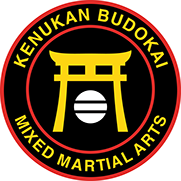
KENUKAN BUDOKAI
"Modern Techniques & Tactics - Traditional Respect & Values"

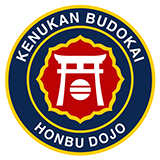
Kenukan Budokai Rank Diplomas
Home / Diplomas
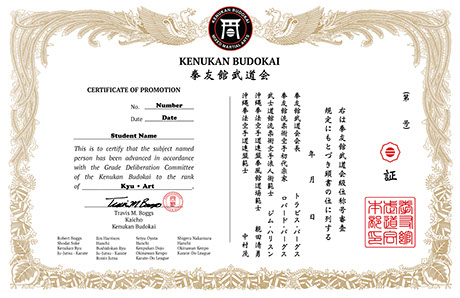
ELEMENTS OF KENUKAN BUDOKAI RANK DIPLOMAS
The design of the Kenukan Budokai rank diplomas conform to the international standards that are recognized by the world’s major martial arts organizations. Traditional Japanese Budo Diplomas have a unique border which distinguishes them as being in accordance with the original diplomas issued by the Dai Nippon Butokukai 大日本武徳会. Historically, many customs and traditions were imported from China to Japan, including elements of the traditional Japanese certificate border. Essentially, the Japanese combined the Phoenix from China and Paulownia from Japan. Originally, it was only used in the Japanese Imperial Court, but by the Meiji Period, it had started to be used by government and municipal offices, including official martial arts diplomas. The Double Phoenix Border has three main elements:
1. Phoenix 鳳凰 - The Phoenix is a one of the mythological animals used in China by the Emperor in the design of official documents. According to legend, the Phoenix has Virtue above the head, Morality on the back, Benevolence in the heart, Faith in the Wings, and Courtesy between the legs. The Phoenix doesn't pick insects, never breaks living plants, never perches on trees, and never eats anything but the fruit from Bamboo. When the Phoenix flies, all the birds follow. It is a symbol of charity and love. On diplomas, the male 鳳 is on the left, and the female 凰 is on the right.
2. Cloud 雲龍 - In the top center of the border, in-between the male and female Phoenix, sits the lucky cloud that brings rain. Cloud 雲 is set with the Dragon 龍 (which is one of the four mythological animals).
3. Paulownia 桐 - The bottom half of the border is arranged by Paulownia leaves. Paulownia and Chrysanthemum are used as the crest in the Imperial Court of Japan.
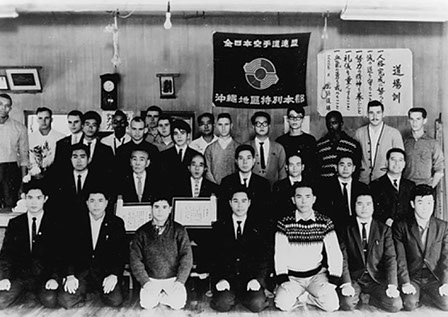
Hanshi Shigeru Nakamura 中村茂 (Row 2, 2nd from left) & Hanshi Zenryo Shimabukuro 島袋 善良 (Row 2, 3rd from left) Displaying Their 10th Dan Rank Diplomas From The All Japan Karate-Do Federation 全日本空手道連盟 (1964)
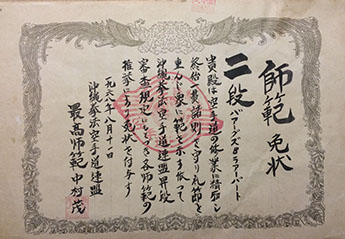
Shihan 師範 Teaching License (Menkyo 免許) Issued To
Sensei Bob Boggs By Hanshi Shigeru Nakamura 中村茂 (1968)
KENUKAN-RYU JAPANESE & OKINAWAN RANK DIPLOMA HISTORY
In Japan, it is customary for martial arts associations to issue Menkyo 免許 (diplomas) to those who have completed the coursework required to advance to the next Kyu 級 (grade) or Dan 段 (degree). In addition to rank, Shugo 称号, or teaching titles, are awarded for the ability to transmit and personify a particular style’s virtues, techniques, tactics, and / or strategies. Historically, the first major Japanese institution authorized to issue such diplomas & licenses was the Dai Nippon Butoku Kai (DNBK) 大日本武徳会 (Greater Japan Martial Virtue Society). Established in 1895, under the authority of the Japanese Ministry of Education, it’s purpose was to restore classical martial arts culture, provide system standardization to the various disciplines, oversee the issuing of licenses, and to educate the population about Budo 武道 (martial way). By 1911, the DNBK had established the Bujitsu Senmon Gakko 武術専門学校 (Martial Arts Professional School), tasked with the responsibility of administering national accreditation, certification, and professional training of the major martial arts disciplines (Judo 柔道, Kendo 剣道, Naginata 薙刀, and Kyudo 弓道). Unfortunately, by WWII, the DNBK had been transformed into the primary mechanism responsible for the training of Japanese soldiers in the various combat disciplines. Thus, in 1946, after the Allied Forced had taken over Japan, the DNBK was dissolved, and all it’s assets were confiscated. In 1951, as a result of the San Francisco Peace Treaty, Japan regained it’s sovereignty. Two years later, in 1953, the DNBK was re-opened with a new philosophical vision and charter.
Although Kodokan Judo 講道館柔道 had been under the authority of the DNBK since it’s inception, Karate-Do had been very unregulated. Originating in Okinawa, Karate-Do was divided into multiple styles, all of which had different training attire and ranking standards. Principally, it was Gichin Funikoshi 船越 義珍, who brought the art to mainland Japan. Funakoshi realized that in order for Karate-Do to be accepted by the Japanese, it was necessary to standardize the art, and conform with the Japanese way of practicing Budo. Implementing ideas originally formulated by Jigoro Kano 嘉納 治五郎 (the founder of Judo), he was able to formalize Karate’s uniform & rank. Thus, the use of the lighter weight karate gi & the adoption of the Kyu / Dan rank system was eventually universally adopted.
The official DNBK regulation of Karate-Do had begun in the 1930’s. However, for Okinawa, the issuing of high Dan ranks and Shugo teaching titles (such as Renshi 錬士, Kyoshi 教士, & Hanshi 範士) didn’t really take hold until after WWII. Specifically, it was under the guidance of Kanken Toyama 遠山寛賢, an Okinawan Karate teacher who had immigrated to mainland Japan in the early 1930’s, that many of the great Okinawan Karate-Do Masters received their official Dan ranks. In 1937, Toyama was given an exclusive license by the DNBK to be able to issue any Dan rank or Shogo title that he felt was deserved. He was the only known Karate-Do teacher in Japan or Okinawa ever to be given this kind of unyielding power.
In 1946, with the objective of unifying Karate-Do in Japan and Okinawa, Kanken Toyama 遠山寛賢, with the help of Chitose Tsuyoshi 千歳 强直, founded the All Japan Karate-Do Federation 全日本空手道連盟 (AJKF). Originally, the organization had included Gichin Funakoshi 船越 義珍 (Shotokan-ryu 松濤館流), Kenwa Mabuni 摩文仁 賢和 (Shito-ryu 糸東流) and Seiko Higa 比嘉 世幸 (Goju-ryu 剛柔流). However, by 1960, it was primarily a Toyama and Chitose group. One of Toyama’s students, Tamotsu Isamu, a former Zenryo Shimabukuro 島袋 善良 student who had been living in Japan, desired to organize Karate-Do under the AJKF banner in Okinawa. In an effort to make this a reality, he held a series of meetings with various Okinawan Karate-Do leaders, including Shimabukuro, whom he eventually convinced to take a leadership position. The end result was the the formation of the AJKF / Okinawa Branch. Its officers were Zenryo Shimabukuro 島袋 善良 (President), Joen Nakazato (Vice President), and the active participation of Shigeru Nakamura 中村茂 (Okinawan Kenpo 沖縄 拳法), Shinsuke Kaneshima (Tozan-ryu), and Yonamine Seigyu (Shorin-ryu). These Okinawan Karate-Ka leaders, along with some of their senior students (who had become Karate-Do instructors themselves), made up the majority of the AJKF / Okinawa. In an effort to solidify relations with the AJKF, the senior participating Okinawan Karate-Ka were invited to the mainland of Japan by Toyama Kanken. However, only Eizo Shimabukuro (Shobayashi Shorin-ryu) went and was awarded a 10th dan (10th degree black belt).
One interesting result of the partnership with the AJKF was the use of Kendo armor (bogu 防具) to be worn as protective gear for sparring (kumite 組手), which had originally been made popular in the schools of southern Japan. Specifically, it was used by Zenryo Shimabukuro and Shigeru Nakamura, who really liked the gear and decided to adapt it for use in their dojos. By 1962, they formed their own training group, called the Okinawa Kenpo Karate-Do Renmei (OKKR) 沖縄拳法空手道連盟. The OKKR was not designed to be a style, but rather a training organization that concentrated on full contact sparring, & practicing a unified set of basic kata 形 (formal practice). From the beginning, due primarily to generational mistrust between the Okinawan and Japanese people, the alliance formed with the AJKF was on unstable footing. Eventually, the All Japan Karate-Do Federation (Okinawa Branch) dissolved. However, prior to that development, its board of directors conferred 10th Dan 十段 on Zenryo Shimabukuro & Shigeru Nakamura (as recognition of their knowledge, ability, and leadership).
As previously mentioned, Shigeru Nakamura’s Okinawan Kenpo Karate-Do Renmei 沖縄拳法空手道連盟 (OKKR) was one of the few organizations that placed an emphasis on full-contact fighting. As Nakamura was once quoted as saying, “No Fighting, No Karate.” In other words, if someone does not apply the Karate techniques they have learned in some type of free-style fighting, then the spontaneous reflex and resistance abilities one would need in a real street situation would not be there. Thus, that person’s ability would be the antithesis of what true karate was originally intended to be - a method of self-defense. Because of the emphasis on free-fighting, the OKKR attracted some of the toughest fighters on the island - including Seiyu Oyata 親田清勇. Seiyu Oyata trained under Shigeru Nakamura and was one of the few Sensei’s who were promoted by the OKKR to 7th Dan.
In 1966, Robert Boggs, while studying at Sensei Oyata’s Kenpukan Dojo 拳風館道場 in Machinato, Okinawa, earned his Sho-dan 初段 (1st Degree Black Belt). Two years later, in 1968, he received his Ni-dan 二段 (2nd Degree Black Belt), his Shihan 師範 teaching certification (unusual for such a low Dan grade to be bestowed this title), and he was given the name Kenukan 拳友館 (Kenyukan) for his dojo. Because Sensei Oyata was a senior high Dan member of the OKKR, all of O’Sensei Robert Boggs’ Rank Diplomas & Teaching License was personally signed & sealed by Shigeru Nakamura himself. Therefore, O’Sensei Robert Boggs’ original rank comes from a long line of descended authority - going all the back to the Dai Nippon Butoku Kai 大日本武徳会.
In 1973, O’Sensei Boggs, then living in Olathe, Kansas, began training under the world-famous Judo & Karate teacher, Jim Harrison. Jim Harrison was known as one of the toughest and most dangerous fighters in the United States during 60’s and 70’s. In 1958, Harrison had earned his Black Belt in Judo 柔道 under Bob Kurth, a US Navy Commando. Although Harrison loved Judo, he also wanted to develop his striking skills to a greater degree. Therefore, in the early 1960’s, he began studying Matsubayashi-ryu 松林流 under Jim Wax, a direct Black Belt under the style’s founder, Shoshin Nagamine 長嶺 将真. By 1964, Harrison had duel Black Belts in both Judo & Karate.
By 1976, O’Sensei Boggs had realized that what he was teaching was no longer the original karate he had learned on Okinawa. Instead, he had used his original training as a foundation, and combined it with many of Jim Harrison’s Judo, Ju-Jitsu, & Karate techniques & tactics. Thus, O’Sensei Boggs decided to call what he was teaching Kenukan-Ryu 拳友館琉 (Fist - Friend - School - Style). Since that time, O’Sensei Boggs has continued to encourage adding anything to the style that is practical and effective in real-life situations - regardless of the source. As a result of Kenukan-Ryu’s multi-disciplinary (Judo / Karate / Ju-Jutsu / Kickboxing / Kobudo / Goshin Jutsu) nature, it has remained one of the nation’s most respected & feared martial arts styles. Several well-respected organizations in Traditional Budo have recognized O'Sensei Boggs & Kenukan-Ryu. These include: World Union of Karate-Do Organizations (WUKO) - 160 Countries, Ju-Jitsu International Federation (JJIF), Pan-American Union of Karate-Do Organizations (PUKO), United Society of Ju-Jitsu Organizations (USJJO), United States Ju-Jitsu Federation (USJJF), USA Karate Federation (USAKF), USA National Karate-Do Federation (USA-NKF), United States Karate-Do Kai (USKK), Bushidokan (Sensei Jim Harrison), and the Russian USSR Full-Contact Kickboxing-Karate Federation (фЕДЕРАЦИЯ КОНТАКТНОГО КАРАТЭ CCCP).
In 1992, the Kenukan Budokai 拳友館武道会 (Kenukan Martial Way Association) was formed as a style organization designed to unite all practitioners of Kenukan-Ryu 拳友館琉. Originally formed by the founder, O’Sensei Robert Boggs, the Presidency is now chaired by his son, Sensei Travis Boggs - who oversees operations & style development. All practitioners of Kenukan-Ryu are eligible to receive an official rank diplomas recognizing their achievement. The diplomas are designed using the traditional international Budo standards and resemble the original documents presented to O’Sensei Boggs on Okinawa in the 1960’s. Not only is it critical to have official documentation of one’s rank, but it is the continuation of a tradition within the style’s development that goes back over 100 years.
220 West Cedar St. • Olathe, KS • 66061 • Tel: 913.782.5425 • E-Mail: kenukan@aol.com
© 2022 KENUKAN ACADEMY. ALL RIGHTS RESERVED.